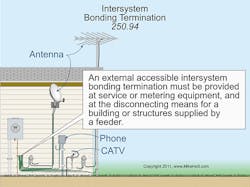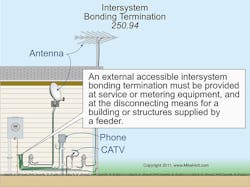All questions and answers are based on the 2011 NEC.
Q. What wiring methods are allowed by the Code in spaces above a lay-in ceiling?
A. Section 300.22(C) applies to spaces used for air-handling purposes, but not fabricated for environmental air-handling purposes. This requirement doesn’t apply to habitable rooms or areas of buildings, the prime purpose of which isn’t air handling.
Informational Note 1: The spaces above a suspended ceiling or below a raised floor used for environmental air are examples of the type of space to which this section applies.
Informational Note 2: The phrase “other space used for environmental air (plenum)” correlates with the term “plenum” in NFPA 90A,Standard for the Installation of Air-Conditioning and Ventilating Systems, and other mechanical codes where the ceiling cavity plenum is used for return air purposes, as well as some other air-handling spaces.
Electrical metallic tubing, rigid metal conduit, intermediate metal conduit, armored cable, metal-clad cable without a nonmetallic cover, and flexible metal conduit can be installed in cavity plenum space. If accessible, surface metal raceways or metal wireways with metal covers can be installed in cavity plenum space [300.22(C)(1)].
PVC conduit [Art. 352], electrical nonmetallic tubing [Art. 362], liquidtight flexible conduit, and nonmetallic cables aren’t permitted to be installed in spaces used for environmental air, because they give off deadly toxic fumes when burned or superheated.
Plenum-rated control, signaling, and communications cables and raceways are permitted in a plenum space:
– CATV [820.179(A)]
– Communications [800.21]
– Control and signaling [725.154(A)]
– Fire alarm [760.7]
– Optical fiber cables and raceways [770.113(C)]
– Sound systems [640.9(C) and 725.154(A)]
Any wiring method suitable for the condition can be used in a space not used for environmental air-handling purposes.
Metal cable tray systems can be installed to support the wiring methods and equipment permitted by this section [300.22(C)(2)(a)].
Electrical equipment with metal enclosures is permitted to be installed in a plenum space [300.22(C)(3)].
Examples of electrical equipment permitted in a plenum space would be air-handlers, junction boxes, and dry-type transformers; however, transformers must not be rated more than 50kVA when located in hollow spaces [450.13(B)].
Q. What is the Code requirement for an intersystem bonding termination, and what is to connect to it?
A. An external accessible intersystem bonding termination for the connection of communications systems bonding conductors must be provided at service equipment or metering equipment enclosure and disconnecting means for buildings or structures supplied by a feeder [250.94], as shown in the Figure. The intersystem bonding termination must:
- Be accessible for connection and inspection.
- Consist of a set of terminals with the capacity for connection of not less than three intersystem bonding conductors.
- Not interfere with opening the enclosure for a service, building/structure disconnecting means, or metering equipment.
- Be securely mounted and electrically connected to service equipment, the meter enclosure, or exposed nonflexible metallic service raceway, or be mounted at one of these enclosures and be connected to the enclosure or grounding electrode conductor with a minimum 6 AWG copper conductor.
- Be securely mounted to the building/structure disconnecting means, or be mounted at the disconnecting means and be connected to the metallic enclosure or grounding electrode conductor with a minimum 6 AWG copper conductor.
- The terminals must be listed as grounding and bonding equipment.
According to Art. 100, an intersystem bonding termination is a device that provides a means to connect communications systems grounding and bonding conductors to the building grounding electrode system.
Exception: At existing buildings or structures, an external accessible means for bonding communications systems together can be by the use of a:
- Nonflexible metallic raceway,
- Grounding electrode conductor, or
- Connection approved by the authority having jurisdiction (AHJ).
Informational Note 2: Communications systems must be bonded to the intersystem bonding termination in accordance with the following Code requirements:
- Antennas/satellite dishes [810.15 and 810.21]
- CATV [820.100]
- Telephone circuits [800.100]
All external communications systems must be connected to the intersystem bonding termination to minimize the damage to them from induced potential (voltage) differences between the systems from a lightning event.
Q. If a single receptacle is installed behind a washing machine within 6 ft of a laundry tub in a dwelling unit, is GFCI protection required?
A. GFCI protection is required for all 15A and 20A, 125V receptacles located within an arc measurement of 6 ft from the outside edge of the sink in dwellings and for other than kitchen sinks [210.8(A)(7)].
Q. Does the rule for GFCI protection of receptacles within 6 ft of a sink apply to undercounter receptacles for dishwashers and kitchen waste disposers in dwellings?
A. No. GFCI protection is required for all 15A and 20A, 125V receptacles that serve countertop surfaces in a dwelling unit [210.8(A)(6)].
GFCI protection is required for all receptacles that serve countertop surfaces, but GFCI protection isn’t required for receptacles that serve built-in appliances, such as dishwashers or kitchen waste disposers. See 210.52(C) for the location requirements of countertop receptacles.
About the Author

Mike Holt
Mike Holt is the owner of Mike Holt Enterprises (www.MikeHolt.com), one of the largest electrical publishers in the United States. He earned a master's degree in the Business Administration Program (MBA) from the University of Miami. He earned his reputation as a National Electrical Code (NEC) expert by working his way up through the electrical trade. Formally a construction editor for two different trade publications, Mike started his career as an apprentice electrician and eventually became a master electrician, an electrical inspector, a contractor, and an educator. Mike has taught more than 1,000 classes on 30 different electrical-related subjects — ranging from alarm installations to exam preparation and voltage drop calculations. He continues to produce seminars, videos, books, and online training for the trade as well as contribute monthly Code content to EC&M magazine.

